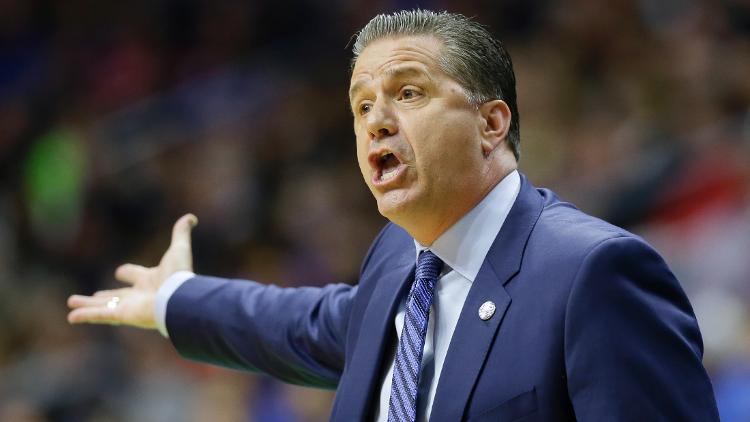Brian Rauf details his five biggest takeaways from the past weekend in college basketball in a brand new Rauf Report.
We are getting down to it! At this point next week, we will all be filling out our brackets and pouring over which upsets to pick, who we think will make the Final Four, and who we have cutting down the nets in Indianapolis.
But, first things first. This weekend simultaneously put a cap on the regular season and saw conference tournament season heat up. Four NCAA Tournament bids have already been handed out — shout out to Morehead State, Winthrop, Liberty, and Loyola-Chicago — with 27 more coming over the next seven days.
As such, this Rauf Report is a bit of a mixed bag. I take a look at Morehead State since they are the least known team of the four already in the field, break down why top 10 teams are surging, and rant about a new rule I want implemented next season.
However, we get things started in the logical place … with Kentucky. That’s how it works, right?
Kentucky’s magic number
In all seriousness, I wanted to lead this Rauf Report with Kentucky for a number of reasons. The Wildcats need to win the SEC Tournament to make the NCAA Tournament which, despite their 9-15 record, is very doable given how wide open the conference is and how much talent is still on Kentucky’s roster. To me, that will be one of the most intriguing storylines of the week ahead.
The biggest thing that has held Kentucky back this season has been their offense. They’re a poor shooting team — 207th in three-point shooting, 294th in effective field goal percentage — that doesn’t move the ball very well and turns it over at a pretty high clip (240th in turnover rate). That said, the Wildcats are doing much better in all those areas of late, and it’s why they’ve closed the season winning five of their last six games.
John Calipari’s squad averaged 70.3 points per game on the season, a number that puts them 225th in the country. That’s not great! But the 70-point plateau has been pretty good barometer for the Wildcats this season.
In Kentucky’s first 15 games, they only scored 70 points or more on three occasions. They went 3-0 in those games. In their last nine games, the Wildcats have hit that mark seven times — a much better rate — and are 4-3.
So, in total, Kentucky is 7-3 when scoring at least 70 points compared to 2-12 when they don’t. That’s a huge, huge difference. And, considering their newfound propensity to hit that mark, Big Blue Nation should be feeling relatively optimistic for the SEC Tournament.
There’s also this: seven of Kentucky’s 15 losses have come by five points or fewer and they lost because, well, they couldn’t generate enough offense late in close games. Now that their offense is flowing better, Calipari feels better about those situations.
“We have gone through the war and we have been scarred, but it prepares us,” Calipari said after the Wildcats beat South Carolina by 28 points on Saturday. “They went through the same war those [past Kentucky] teams went through. The only difference is about four of them or five of them that we could have won, those teams won. We happened to drop.”
Kentucky’s defense has always been solid thanks to their length, athleticism, and versatility. If their offense can continue to hit that 70-point mark, the Wildcats have a chance to make a run in the SEC Tournament.
Illinois’ X-factor
Illinois put a stamp on their spectacular regular season on Saturday with a 73-68 comeback victory over Ohio State in Columbus. The victory was the Illini’s 11th in their last 12 games and second straight over a top 10 team (Michigan), putting them in excellent position to be a No. 1 seed in the NCAA Tournament.
This stretch was in doubt given three of those games were played without start guard Ayo Dosunmu, who suffered a facial injury in their loss to Michigan State. He returned for the win over the Buckeyes, but his time away forced the Ilini’s role players into larger roles, something head coach Brad Underwood wanted to see.
“I don’t know if there’s a silver lining in losing the best player in college basketball,” Underwood told reporters Friday. “I think one thing it’s done is change some roles. Guys got a lot of minutes, guys got put in some different spots. Now it’s just sliding Ayo back in and we don’t have to change a lot of roles. We know we can be good.”
Everyone stepped up, but no one has stepped up as much as Andre Curbelo. The freshman point guard has had an up-and-down season but took over starting duties in Dosunmu’s absence and flourished. He handled more of a scoring role and was more active while also being more efficient.

This is important for a number of reasons. First, Curbelo is the leader of the second unit and is showing he can carry the load. He is also giving Illinois a legitimate third scoring option behind Dosunmu and Kofi Cockburn, which raises this team’s ceiling even more.
And, just as importantly, he showed against Ohio State that he can maintain this production while playing alongside Dosunmu. Both guards scored 19 points against the Buckeyes with Curbelo leading the team in assists (six) and finishing second in rebounds (five).
Curbelo’s rise from bench sparkplug to third scoring option has made Illinois the nation’s most dangerous team outside of Gonzaga and Baylor, and potentially even on that same tier. His impact is immense, and needed, for a team with legitimate Final Four hopes.
Oklahoma State’s ceiling
If we want to talk Final Four hopes, Oklahoma State is a team that has entered that mix over the last month.
The Cowboys have won six of their last seven games with the lone loss coming to Baylor, a game they were in for 39 minutes before Cade Cunningham injured his ankle. Neither he nor Isaac Likekele, Oklahoma State’s second-best player, suited up for the Cowboys against West Virginia in the regular season finale, yet they still found a way to beat a top 10 Mountaineers team on the road, thanks to Avery Anderson and his 31 points.
“I looked those kids in the eye right before the game,” head coach Mike Boynton said after that game. “We expect to win. I understand why people assume we wouldn’t have a chance to win. But those kids are warriors. I was not surprised at all by the way we played.”
Many were surprised, however. Oklahoma State has been touted as The Cade Cunningham Show all year, and the win over West Virginia served as a spotlight game for how good the rest of the roster has been.
Anderson (who was featured in a Rauf Report last week) has become a lethal secondary scoring option and lit up the Mountaineers for a career-high 31 points. Kalib and Keylan Boone showcased their versatility on both ends. Matthew-Alexander Moncrieffe did excellent work down low against a good WVU frontcourt.
Cunningham has shown the ability to take over games frequently (he’s the projected No. 1 pick for a reason), but it takes a deep team to make a long run in the NCAA Tournament. And, not only have Oklahoma State’s role players stepped up, but this group has proven they can win in a multitude of ways.
The Cowboys won a 94-90 shootout with Oklahoma last weekend. They won a 67-64 defensive slugfest with Wichita State, who won the American. This group has won close games, going a perfect 4-0 in overtime contests. They have beaten good teams both at home and on the road.
Oklahoma State’s exact ceiling will depend on the region they are placed in and the matchups that present themselves (everyone wants to avoid Gonzaga and Baylor), but this is a team that looks like a solid bet to make it to the Sweet 16 at least, with Elite Eight and Final Four appearances as definite possibilities if things break right.
Why Morehead State is a dangerous mid-major in the NCAA Tournament
Let’s shift over to Morehead State, shall we? I wanted to do a quick breakdown of the Eagles because I know they’re the one team that has already claimed an auto bid that most fans don’t know anything about. That’s fine! That’s one of the things that makes this time of year great and, well, is one of the reasons you’re reading this piece.
The most important thing to know about Morehead State is that they are red hot. The Eagles have won 19 of their last 20 games after starting 4-6, which included losses to Kentucky, Richmond, Ohio State, and Clemson. None of those games were particularly close, either.
However, after that, the coaching staff put an increased emphasis on the defensive side of the ball, which has paid off. Morehead State ranks 71st in adjusted defensive efficiency, per KenPom, allowing just 61.2 points per game over their last 20.
Assistant coach Jonathan Mattox also told College Basketball Heat Check on All-Access Media that they “learned a lot about themselves” after that start and it helped them get better. Part of that was learning freshman big man Johni Broome could be a huge factor for them.
The 6-10, 235-pounder led the Eagles in scoring, rebounding, and blocks, and impacted all those areas at a level to resonated nationally. Broome ranks 181st nationally in effective field goal percentage, 24th in offensive rebounding rate, 38th in defensive rebounding rate, and 53rd in block rate. He put on a show against Belmont in the OVC Tournament title game, too, racking up 27 points and 12 rebounds.
All this being said, I do not think Morehead State is on the same tier as Loyola-Chicago or Winthrop. But, if the right matchup comes along, this is a group that can pull another upset in the NCAA Tournament’s first round.
Please put a shot clock on replay reviews
Along with emphasizing the true charge rule this offseason, I really hope the NCAA looks at putting in a shot clock or timer of some kind on replay reviews. There are several games every season that get completely taken out of rhythm because of lengthy reviews.
This weekend, that game was Iowa-Wisconsin. The final minute of game time took over 20 minutes of real time to complete, prompting me to tweet out the idea.
I’m not advocating for getting rid of instant replay, because I do think it has a necessary place in the sport. When used properly, it’s a good thing. But it needs to be used to find clear and obvious errors, not potential errors we have officials look at for five minutes before deciding there isn’t enough evidence to overturn the original call.
Clear and obvious errors are just that — clear and obvious. You should be able to tell those kinds of mistakes only two or three looks at the play. So, let’s put a clock on it and stick with the original call if we can’t make a decision before it runs out so we can get back to the game on the court.


You must be logged in to post a comment.